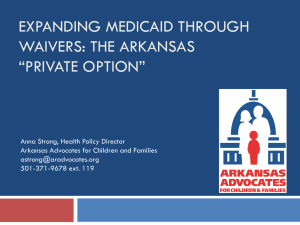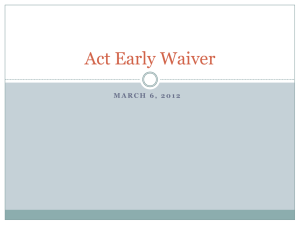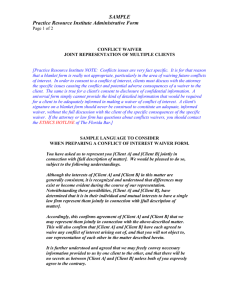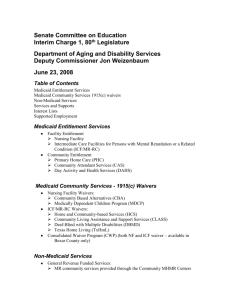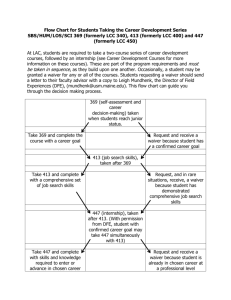Waiver Rate Study
advertisement
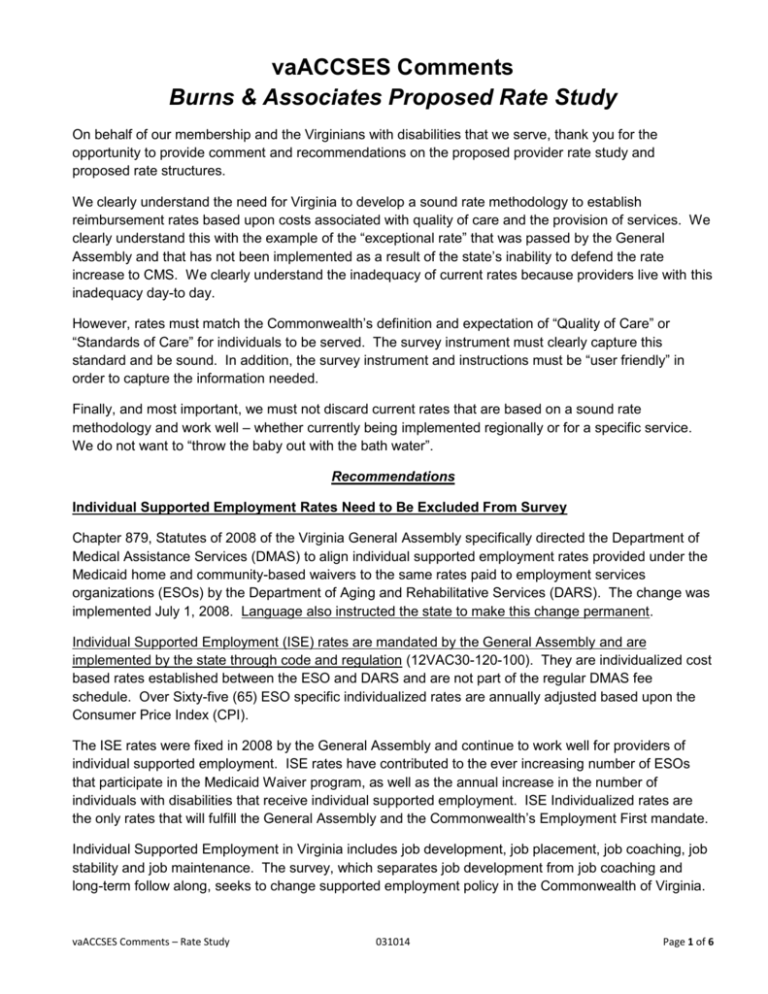
vaACCSES Comments Burns & Associates Proposed Rate Study On behalf of our membership and the Virginians with disabilities that we serve, thank you for the opportunity to provide comment and recommendations on the proposed provider rate study and proposed rate structures. We clearly understand the need for Virginia to develop a sound rate methodology to establish reimbursement rates based upon costs associated with quality of care and the provision of services. We clearly understand this with the example of the “exceptional rate” that was passed by the General Assembly and that has not been implemented as a result of the state’s inability to defend the rate increase to CMS. We clearly understand the inadequacy of current rates because providers live with this inadequacy day-to day. However, rates must match the Commonwealth’s definition and expectation of “Quality of Care” or “Standards of Care” for individuals to be served. The survey instrument must clearly capture this standard and be sound. In addition, the survey instrument and instructions must be “user friendly” in order to capture the information needed. Finally, and most important, we must not discard current rates that are based on a sound rate methodology and work well – whether currently being implemented regionally or for a specific service. We do not want to “throw the baby out with the bath water”. Recommendations Individual Supported Employment Rates Need to Be Excluded From Survey Chapter 879, Statutes of 2008 of the Virginia General Assembly specifically directed the Department of Medical Assistance Services (DMAS) to align individual supported employment rates provided under the Medicaid home and community-based waivers to the same rates paid to employment services organizations (ESOs) by the Department of Aging and Rehabilitative Services (DARS). The change was implemented July 1, 2008. Language also instructed the state to make this change permanent. Individual Supported Employment (ISE) rates are mandated by the General Assembly and are implemented by the state through code and regulation (12VAC30-120-100). They are individualized cost based rates established between the ESO and DARS and are not part of the regular DMAS fee schedule. Over Sixty-five (65) ESO specific individualized rates are annually adjusted based upon the Consumer Price Index (CPI). The ISE rates were fixed in 2008 by the General Assembly and continue to work well for providers of individual supported employment. ISE rates have contributed to the ever increasing number of ESOs that participate in the Medicaid Waiver program, as well as the annual increase in the number of individuals with disabilities that receive individual supported employment. ISE Individualized rates are the only rates that will fulfill the General Assembly and the Commonwealth’s Employment First mandate. Individual Supported Employment in Virginia includes job development, job placement, job coaching, job stability and job maintenance. The survey, which separates job development from job coaching and long-term follow along, seeks to change supported employment policy in the Commonwealth of Virginia. vaACCSES Comments – Rate Study 031014 Page 1 of 6 The ISE individualized rate structure is one of the only Medicaid waiver rates that meet the needs of providers and individuals with disabilities that it serves. What is mandated by the General Assembly and works well - must not be tampered with or needs to be fixed. Fundamental Flaw Exists with Survey The survey starts by asking the provider to begin their calculation by using their current pay scale for direct service professionals (DSP) which has been arguably kept low due to inadequate Medicaid reimbursement since the inception of Virginia’s Medicaid home and community-based waivers. Many providers must pay wages that are limited by current Medicaid reimbursement. Because the survey asks providers to begin their calculation by using the current pay scale for DSPs, the survey instrument is flawed from the initial question. A rate built on an insufficient wage will continue to be insufficient. Regional Rate Setting Protocols Already Exist There is an alternative approach, at least for day and employment providers that could replace the need for the surveys and result in the immediate submission of accurate data on rates charged for day and employment services. A regional rate setting protocol has established these rates, based on review, analysis and negotiation. Currently, the Region II CSBs participate in a regional rate setting protocol, along with DARS and NVTC. Based on regional negotiations among these public agencies and the numerous providers, rates are negotiated and published. These provider specific rates are then accepted for purchase of service by these 5 CSBs, by DARS, by NVTC, and by and local ICFs within Region II. There are published rates to provide the resulting information that Burns and Associates is seeking to calculate for day support, pre-vocational and group supported employment services. In the cases of these day and employment services, no survey is needed since the information is already publicly available from Region II. It is acknowledged that this alternative is specific to Region II but Region II represents about 25% of the State population and about 13% of all active ID Waiver slots. It may be possible to propose some mathematical calculations and extrapolations to adjust these rates to reflect what day and employment services cost in other areas of Virginia. A sampling protocol for other Waiver services (beyond these day and employment services) is strongly recommended. With regional differences, and varying sizes and administrative capabilities of individual providers, it is likely that results could be more accurately achieved by strategically managing the survey completions. Survey Instrument is Complex, Lacks Consistent Language and Requires Clarity We recommend that the survey instrument be more “user friendly”, include consistent language and be as simple to complete as possible. The survey is overwhelming and many smaller providers cannot afford to employ staff specifically trained in fiscal skills and therefore may not be able to complete the survey. It also requires many providers to publish what they consider to be proprietary information. This leads to the concern that any responses received will be skewed based on which providers are able to complete the survey. Providers that are best equipped to compute the survey will not be a statistically acceptable sample. vaACCSES Comments – Rate Study 031014 Page 2 of 6 Clear Definitions and Terms The survey includes numerous assumptions that all providers understand the terms and what is included in certain categories. What can be possibly misunderstood – will be misunderstood. Clear definitions of terms is strongly recommended. Below are some examples of terms that need specific definitions to ensure consistent responses by providers since these terms may be interpreted and expensed differently by different providers based on their business models. o o o o o o o o o o o The use of the term “typical week” suggests using an “average” which will automatically lower the data collected. Is the survey capturing people or FTEs? This needs to be clear and consistent throughout the survey. “Fringe benefit” must be clearly defined and be consistently implemented throughout the survey and survey instructions. It is used as a term in one example while employee related benefits are used on another. Still, the abbreviation ERE is used on another. “Paid Holidays” must be clearly defined. (residential staff work 24/7 so holidays are managed differently than by providers of other services) “Period of time captured” must be clearly defined and consistent throughout the survey and survey instructions. “Last year”, “FY13” and “2014” are used throughout the survey. A date certain or specific period of time needs to be stated and needs to be consistent throughout. Terminology for ID is sometimes different for DD (i.e. ISP vs POC). “Annual Turnover” needs clarity. Does this include whether it is a clear separation and/or promotion? A specific formula is required since providers approach this differently. “Overtime” needs to be clearly defined. Some providers pay overtime while some use relief staff. If Overtime is figured into the total wage paid in the survey, the average wage figure will be inflated but alternatively if Overtime is not included, the average wage will be insufficient to cover costs. A precise instruction is needed. Case Management as a function of a provider needs to be clarified. “Optional Benefits” needs to be clarified. The term “optional” needs clarity especially in light of ACA employer requirements. “Corporate office” versus “Administrative Office” overhead and the differences between the two needs to be clearly defined. This is especially true for small providers working in a single home. They need clarity since their “overhead” is not based in a corporate office. Clear and Detailed Instructions The following topics need to be more clearly described so providers can respond appropriately: Each section of the survey should include a notation “See page ______in Instructions”. In the revenue sections, are we capturing only ID and DD waiver funding or all ID/DD funding that includes waiver, local and/or private funding? This needs to be clearly indicated in the instructions. “Non-billable time” must be clearly defined in each instance that it is used in the survey and survey instructions. For example, providers engaged in day support find their DSPs engaged in very time consuming activities related to both the use and maintenance of adaptive equipment as well as the clean-up of changing tables after self-care and food preparation prior to lunch and snacks. These vaACCSES Comments – Rate Study 031014 Page 3 of 6 activities may not include the participants being present but are critical for health, safety and service provision. o Communication with collaterals - DSPs are often discussing clinical issues with other provider staff, with CSB staff and/or with family collaterals and this communication and coordination is essential but it does reduce direct “billable time”. There needs to be a basic explanation of how collateral time may or may not be identified as billable. o Documentation. Is a fuller term than progress notes since documentation also includes items such as incident reports and CHRIS entries and not just daily notes. o Consideration should be given to an additional “miscellaneous” category and allow a nominal exclusion factor. Providers could continue to identify other interruptions and arguably some of the example above may apply differently to different providers. “Paid Days Off” needs to include “Inclement weather” paid days off in Virginia because of snow days, hurricanes, tropical storms, etc. “Administrative Costs and %” – is unemployment insurance and workman’s comp included and where? Administrative Support % - Since many funding sources, such as the federal government, set the limit to 15% for administrative costs, would it be simpler to enter that as a cap on all surveys rather than expect providers to calculate it individually? “Program Support Costs and %” - Instructions should be provided that this category is more inclusive than just supervisors but should include all other staff who is neither DSP nor administrative, for example, Quality Assurance staff or those providing specific therapeutic interventions not contained in other service models. “Productivity” section needs clarity. Currently assumes that a DSP can devote all time to direct care EXCEPT for the listed “interruptions”. These are displayed as “productivity assumptions” but they are in fact “productivity reduction factors” since they interrupt or distract from billable time. The instructions must be clear on this and should include more examples. This is a key factor in deriving an honest cost of service since providers must pay for their staff to complete these activities but Medicaid may not allow them as billable activities. “Employer Development” costs need to be captured with Group Supported Employment. This includes, but is not limited to, identifying employer opportunities and working with employers to develop enclave and work crew opportunities within their business structure. The front end costs of this service are extremely tough, time consuming and thus, costly. “Vehicle Costs” needs to be expanded and clearly defined. The cost associated with a regular vehicle or regular van is very different from a para-transit van. Also, does this include staff classroom training and “on the road” training costs, maintenance costs, insurance, vehicle related safety supplies, GPS supplies and fees, e-record database systems and training OR is this captured under Staff development is a preferred term rather than training and providers acknowledge that staff development is required by regulations. Staff development which includes “Training Costs” needs to be expanded and clearly defined. Costs associated with all training needs to be clarified and captured including training in Human Rights, incident reporting, medical administration, CPR/First Aid, and professional certification training, as well as required DSP waiver training. “Attendance” should be standardized for day providers with an example such as “52 weeks times 5 days is 260 days then minus 10 holidays and minus 4 weather closings and minus one staff training days results in 245 days” that the program is open for business. Then that number is further reduced by a utilization factor, which is driven by the actual attendance of the recipients. Providers have historical data and these data should correlate to the service models since, for example, more medically fragile individuals in day support would traditionally have lower attendance than those individuals who work regularly in individual supported employment. This factor in the equation is very critical in rate derivation. vaACCSES Comments – Rate Study 031014 Page 4 of 6 Group Size is another key factor in actually deriving the rate - especially with the distinctions among tiers. Staffing ratios need to account for smaller ratios including 1:2 or 1:1 to implement appropriate Standards of Care for some with extraordinary medical and behavioral needs. Mileage – This should include clear examples to providers on examples of operating expenses for purchased vehicles (such as maintenance, insurance and fuel) and an option to enter leasing costs rather than purchase price if applicable. Facility expenses—Supplies should be entered here. Employer requirements may need augmentation with some examples for providers. SIS Since the SIS scores will be used to determine tiers and these tiers will subsequently be applied to determine reimbursement rates, it is necessary to provide additional information on how the SIS scores will be calculated along with a discussion on defining tiers. As an example, DBHDS has publicly stated that the SIS will function as “one of the tools”. DBHDS needs to provide clarity on which tools are being proposed and how the descent of tier rankings will occur based on scores. This is critical background information if providers are expected to propose staffing support ratios for each tier in their rate calculation since they will need instructions as to the definitions of the tiers. In order to achieve consistency among respondents, this information on the tiers must be provided along with survey instructions. Other Personal Assistance & Respite – These services are not unique services under the ID/DD waivers. Serious consideration should be given to including these services in the survey since they are linked to Personal Care rates under other waivers. Since both services can also be provided in a congregate setting how should providers separate the costs for space, time, equipment & personnel? Sponsored Residential - It is unlikely that providers of sponsored residential will be able to complete the survey as constructed. Compensation derives mostly from the Medicaid waiver reimbursement rate for the number of hours authorized by the individual’s plan for support, minus a small percentage retained by the licensed agency in order to cover the costs of technical and clinical support and supervision. “Host home” providers are independent contractors, rather than employees of the licensed Sponsored Residential agency that sponsors them. Each signs a contract with the licensed agency for the services to be rendered. Each signs an additional service agreement that is, in effect, a three-party agreement between the “host home”, the licensed agency and the individual to be served. The responsibilities of a “host home” are similar to those of both a group home manager and a direct support provider. Group Home Detail – How should providers reflect individual differences which are part of a person centered plan? For example, one of four individuals has a job for 6 hours a week, 5 days per week, one works 3 days per week, and the remaining residents choose to have no organized day program but enjoy volunteering some days and relaxing at home on others. How do providers calculate these hours or differentials within one cell? The Congregate Residential Model - should reflect an attendance modifier for any day activities and would, of course, vary according to the level of disability of each resident. There should not be the assumption that a residential site would be homogeneous for all residents and that, for example, all residents work 90% of the time. vaACCSES Comments – Rate Study 031014 Page 5 of 6 The survey and example lack the opportunity to display the owner’s “contributions” or “in-kind” value in an environment where the owner does not draw a wage. If the survey template is distributed with numbers already inserted as placeholders or examples, these existing numbers may confuse providers who may interpret these numbers as fixed in the formulas. When templates are used, no numerical information should be entered into the cells and directions must be clear on exactly which numbers each respondent should enter. For more information please contact: Karen Tefelski Executive Director Ktefelski@vaaccses.org (703) 200-7660 Dave Wilber President vaACCSES and COO VersAbility Resources dwilber@versAbiity.org (757) 896-8450 vaACCSES Comments – Rate Study 031014 Page 6 of 6
